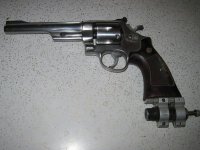Doyle,
The faster a powder is, the less you need to achieve a given peak pressure. It will, however, also produce less velocity for a given peak pressure because it reaches peak pressure before the bullet has moved as far down the tube as it does when a slow powder reaches peak pressure. Thus, the volume the fast powder's pressure peaks in is smaller. That's why you use a lighter charge. A heavier charge would make too much gas for that smaller space and would exceed the pressure limit for the cartridge. This lower gas quantity also means that as the bullet goes down the tube, expanding the burning space, pressure drops faster and accelerates the bullet less after the peak. That's why the velocity produced is lower, even though the peak pressure is the same.
The reason slower powders that produce higher velocity also produce a lot of flash is the pressure and temperature of their propellant gases are higher when the bullet clears the muzzle due to the greater total quantity of gas they make at their maximum charge weights. That greater gas quantity also supplies more fuel to burn with oxygen from the air it meets as it exits. Nitrocellulose combustion is an oxygen deficient reaction, and so there is unoxidized carbon, hydrogen, and nitrogen in its gases. This is why it leaves unburned carbon in your bore. But if they are hot enough to ignite, those excess fuel molecules happily burn in air.
If you use powder with a flash suppressant, this can help a good deal. They will use a something that lowers the temperature of combustion and therefore of the expelled gas. This reduces the flame temperature and brightness.
The faster a powder is, the less you need to achieve a given peak pressure. It will, however, also produce less velocity for a given peak pressure because it reaches peak pressure before the bullet has moved as far down the tube as it does when a slow powder reaches peak pressure. Thus, the volume the fast powder's pressure peaks in is smaller. That's why you use a lighter charge. A heavier charge would make too much gas for that smaller space and would exceed the pressure limit for the cartridge. This lower gas quantity also means that as the bullet goes down the tube, expanding the burning space, pressure drops faster and accelerates the bullet less after the peak. That's why the velocity produced is lower, even though the peak pressure is the same.
The reason slower powders that produce higher velocity also produce a lot of flash is the pressure and temperature of their propellant gases are higher when the bullet clears the muzzle due to the greater total quantity of gas they make at their maximum charge weights. That greater gas quantity also supplies more fuel to burn with oxygen from the air it meets as it exits. Nitrocellulose combustion is an oxygen deficient reaction, and so there is unoxidized carbon, hydrogen, and nitrogen in its gases. This is why it leaves unburned carbon in your bore. But if they are hot enough to ignite, those excess fuel molecules happily burn in air.
If you use powder with a flash suppressant, this can help a good deal. They will use a something that lowers the temperature of combustion and therefore of the expelled gas. This reduces the flame temperature and brightness.

